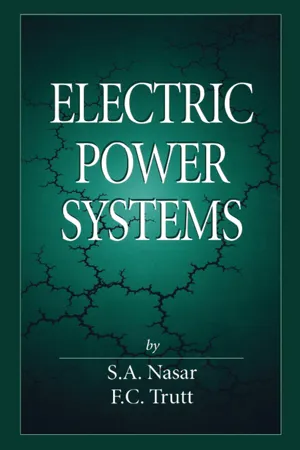
This is a test
- 320 pages
- English
- ePUB (mobile friendly)
- Available on iOS & Android
eBook - ePub
Electric Power Systems
Book details
Book preview
Table of contents
Citations
About This Book
The field of electrical engineering has become increasingly diversified, resulting in a spectrum of emerging topics - from microelectromechanics to light-wave technology. Keeping pace with progressing technology, and covering the scope of related subjects, Electric Power Systems provides introductory, fundamental knowledge in several areas. The tex
Frequently asked questions
At the moment all of our mobile-responsive ePub books are available to download via the app. Most of our PDFs are also available to download and we're working on making the final remaining ones downloadable now. Learn more here.
Both plans give you full access to the library and all of Perlego’s features. The only differences are the price and subscription period: With the annual plan you’ll save around 30% compared to 12 months on the monthly plan.
We are an online textbook subscription service, where you can get access to an entire online library for less than the price of a single book per month. With over 1 million books across 1000+ topics, we’ve got you covered! Learn more here.
Look out for the read-aloud symbol on your next book to see if you can listen to it. The read-aloud tool reads text aloud for you, highlighting the text as it is being read. You can pause it, speed it up and slow it down. Learn more here.
Yes, you can access Electric Power Systems by Syed A. Nasar, F.C Trutt in PDF and/or ePUB format, as well as other popular books in Technology & Engineering & Electrical Engineering & Telecommunications. We have over one million books available in our catalogue for you to explore.
Information
CHAPTER
1
1
INTRODUCTION
In this book, our goal is to develop a qualitative and quantitative understanding of electric power systems. The study of electric power systems is concerned with the generation, transmission, distribution, and utilization of electric power. Thus, the scope of study is schematically represented by Figure 1.1, which shows a coal-fired electric power plant providing electricity to a customer. We will study the major electrical components of this system, as well as the overall system itself. The main electrical components of this system are generators, transformers and transmission lines. Study of their roles in power system operation will be the subject matter of this book. Whereas Figure 1.1 illustrates the theme of the book, we will also study interconnected systems whereby several power generating systems are interconnected with each other. Such an interconnection between individual systems is necessary for an economic and reliable delivery of electric energy to the consumer. Referring to Figure 1.1, we notice that thermal energy is being converted to electric energy at the generating station. The electric energy is then transmitted to a substation which may be at a location near the consumer. In general, the generating station is located away from the consumer. Thus, one of the major advantages of utilizing electric power is that it may be conveniently transmitted from the point of generation to the point of utilization. This aspect leads us to the study of power transmission lines. In our study of a power system we will include its normal as well as abnormal behavior. This latter mode of behavior determines the choice of protective equipment in a power system. In summary, we will present a discussion of the operation of transmission lines, power system protection equipment and the overall behavior of a power system. Before we embark on this study, in the present chapter, we review certain basic concepts relevant to energy and power. Furthermore, in order to assess the energy perspective quantitatively, we first introduce certain units and basic definitions. Next, we will briefly discuss the concept of growth rates. This concept is useful in planning for the future. We will end this chapter with a discussion of major energy sources and limitations to electric power generation.

FIGURE 1.1
A coal-fired steam generating station supplying a home.
A coal-fired steam generating station supplying a home.
1.1 ENERGY AND POWER
Let a force F be applied to a mass so as to move the mass through a linear displacement l in the direction of F. Then the work Q done by the force is defined as the product Fl; that is,
(1.1) |
If the displacement is not in the direction of F, then the work done is the product of the displacement and the component of the force along the displacement, that is,
(1.2) |
where α is the angle that F makes with l. Work is measured in joules (J). From (1.1), one joule is the work done by a force of one newton in moving a body through a distance of one meter in the direction of the force: 1J = 1 Nm.
The energy of a body is its capacity to do work. Energy has the same unit as work, although several o...
Table of contents
- Cover
- Half Title
- Title Page
- Copyright Page
- Table of Contents
- PREFACE
- CHAPTER 1 - INTRODUCTION
- CHAPTER 2 - AC CIRCUIT ANALYSIS
- CHAPTER 3 - COMPONENTS OF ELECTRIC POWER SYSTEMS
- CHAPTER 4 - POWER FLOW STUDIES
- CHAPTER 5 - FAULT CALCULATIONS AND POWER SYSTEM PROTECTION
- CHAPTER 6 - POWER SYSTEM STABILITY
- CHAPTER 7 - POWER SYSTEM OPERATION AND CONTROL
- APPENDIX I - CHARACTERISTICS OF ALUMINUM CONDUCTORS
- APPENDIX II - POWER TRANSFORMERS
- APPENDIX III - SYNCHRONOUS MACHINES
- APPENDIX IV - POWER TRANSMISSION LINES
- BIBLIOGRAPHY
- INDEX